2004 BUICK PARK AVENUE torque
[x] Cancel search: torquePage 98 of 410
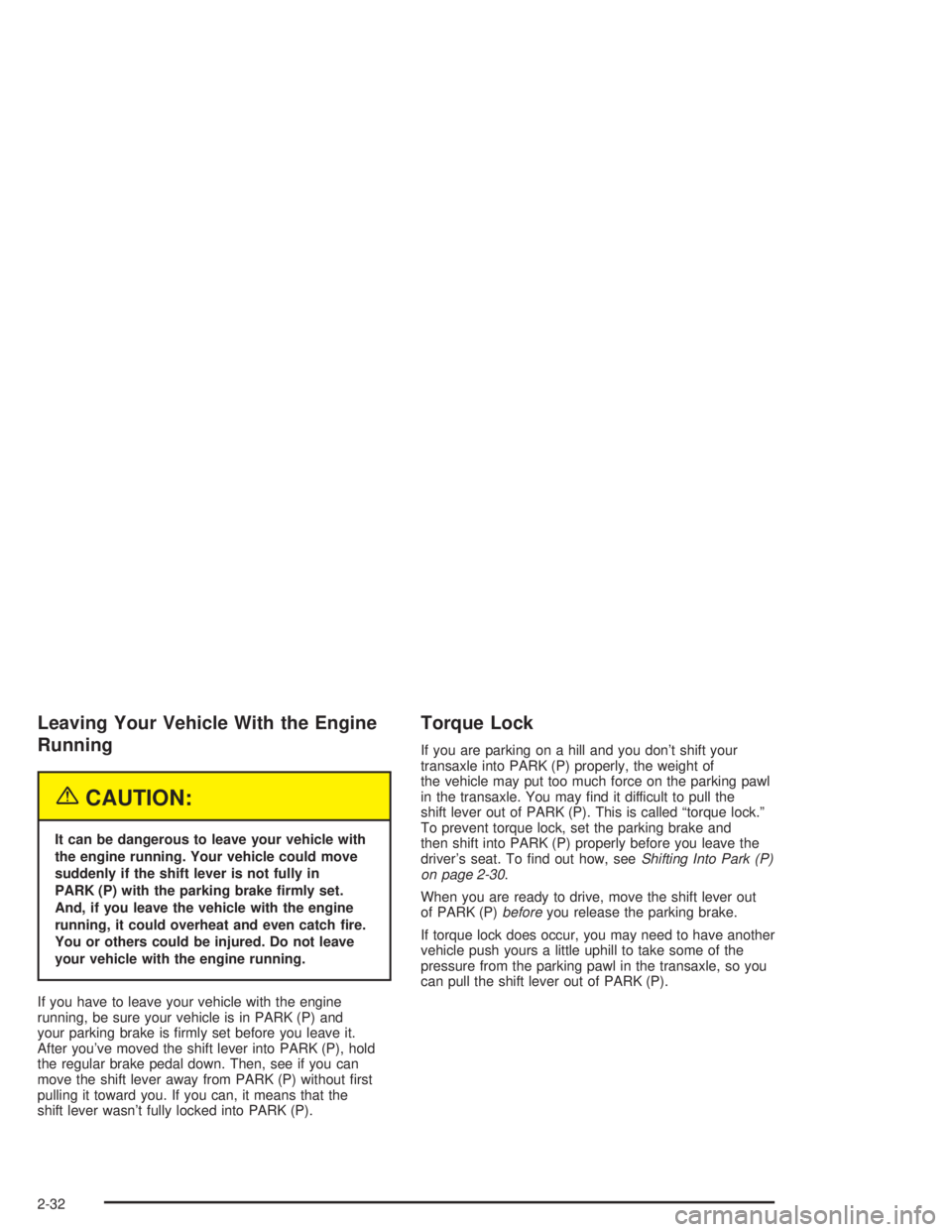
Leaving Your Vehicle With the Engine
Running
{CAUTION:
It can be dangerous to leave your vehicle with
the engine running. Your vehicle could move
suddenly if the shift lever is not fully in
PARK (P) with the parking brake �rmly set.
And, if you leave the vehicle with the engine
running, it could overheat and even catch �re.
You or others could be injured. Do not leave
your vehicle with the engine running.
If you have to leave your vehicle with the engine
running, be sure your vehicle is in PARK (P) and
your parking brake is �rmly set before you leave it.
After you’ve moved the shift lever into PARK (P), hold
the regular brake pedal down. Then, see if you can
move the shift lever away from PARK (P) without �rst
pulling it toward you. If you can, it means that the
shift lever wasn’t fully locked into PARK (P).
Torque Lock
If you are parking on a hill and you don’t shift your
transaxle into PARK (P) properly, the weight of
the vehicle may put too much force on the parking pawl
in the transaxle. You may �nd it difficult to pull the
shift lever out of PARK (P). This is called “torque lock.”
To prevent torque lock, set the parking brake and
then shift into PARK (P) properly before you leave the
driver’s seat. To �nd out how, seeShifting Into Park (P)
on page 2-30.
When you are ready to drive, move the shift lever out
of PARK (P)beforeyou release the parking brake.
If torque lock does occur, you may need to have another
vehicle push yours a little uphill to take some of the
pressure from the parking pawl in the transaxle, so you
can pull the shift lever out of PARK (P).
2-32
Page 286 of 410
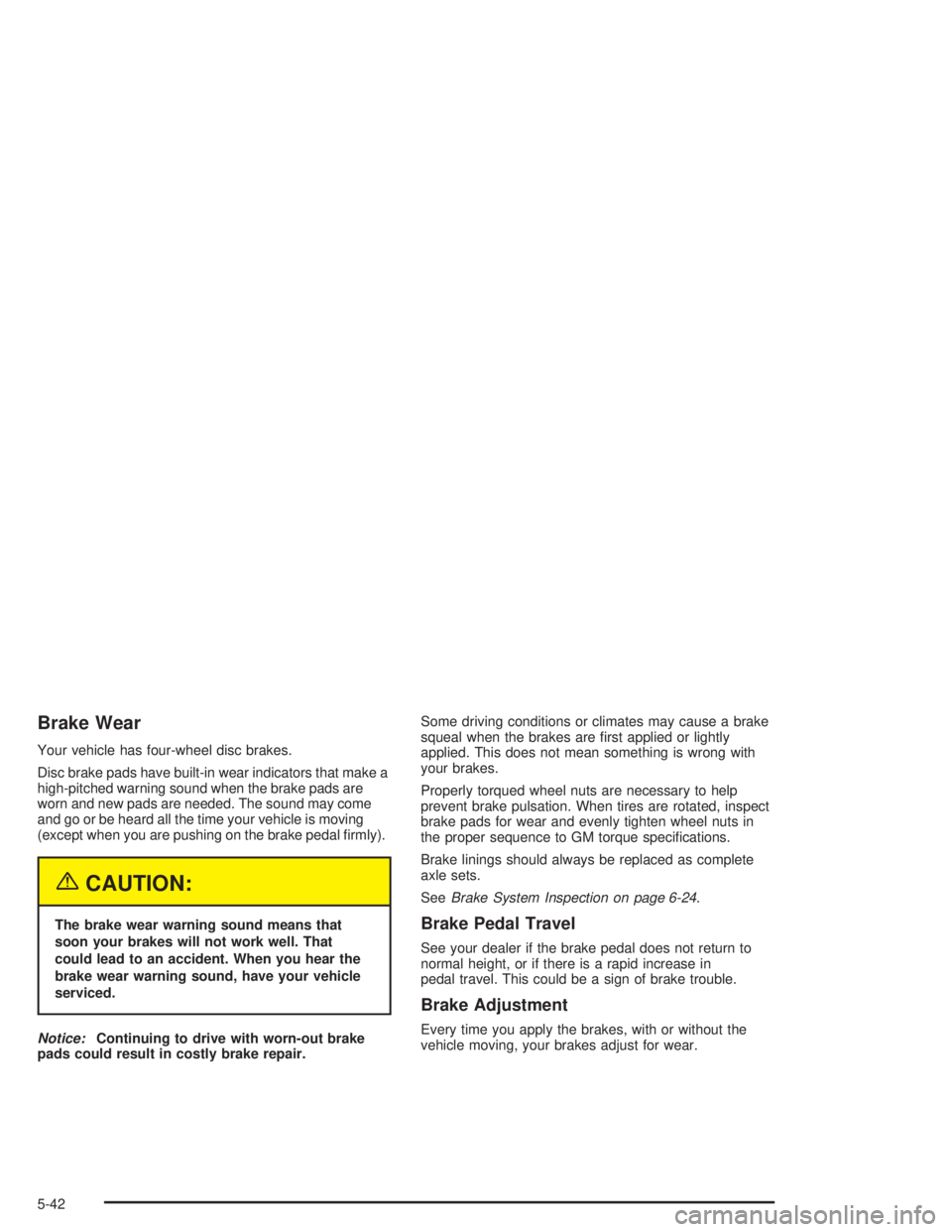
Brake Wear
Your vehicle has four-wheel disc brakes.
Disc brake pads have built-in wear indicators that make a
high-pitched warning sound when the brake pads are
worn and new pads are needed. The sound may come
and go or be heard all the time your vehicle is moving
(except when you are pushing on the brake pedal �rmly).
{CAUTION:
The brake wear warning sound means that
soon your brakes will not work well. That
could lead to an accident. When you hear the
brake wear warning sound, have your vehicle
serviced.
Notice:Continuing to drive with worn-out brake
pads could result in costly brake repair.Some driving conditions or climates may cause a brake
squeal when the brakes are �rst applied or lightly
applied. This does not mean something is wrong with
your brakes.
Properly torqued wheel nuts are necessary to help
prevent brake pulsation. When tires are rotated, inspect
brake pads for wear and evenly tighten wheel nuts in
the proper sequence to GM torque speci�cations.
Brake linings should always be replaced as complete
axle sets.
SeeBrake System Inspection on page 6-24.Brake Pedal Travel
See your dealer if the brake pedal does not return to
normal height, or if there is a rapid increase in
pedal travel. This could be a sign of brake trouble.
Brake Adjustment
Every time you apply the brakes, with or without the
vehicle moving, your brakes adjust for wear.
5-42
Page 317 of 410
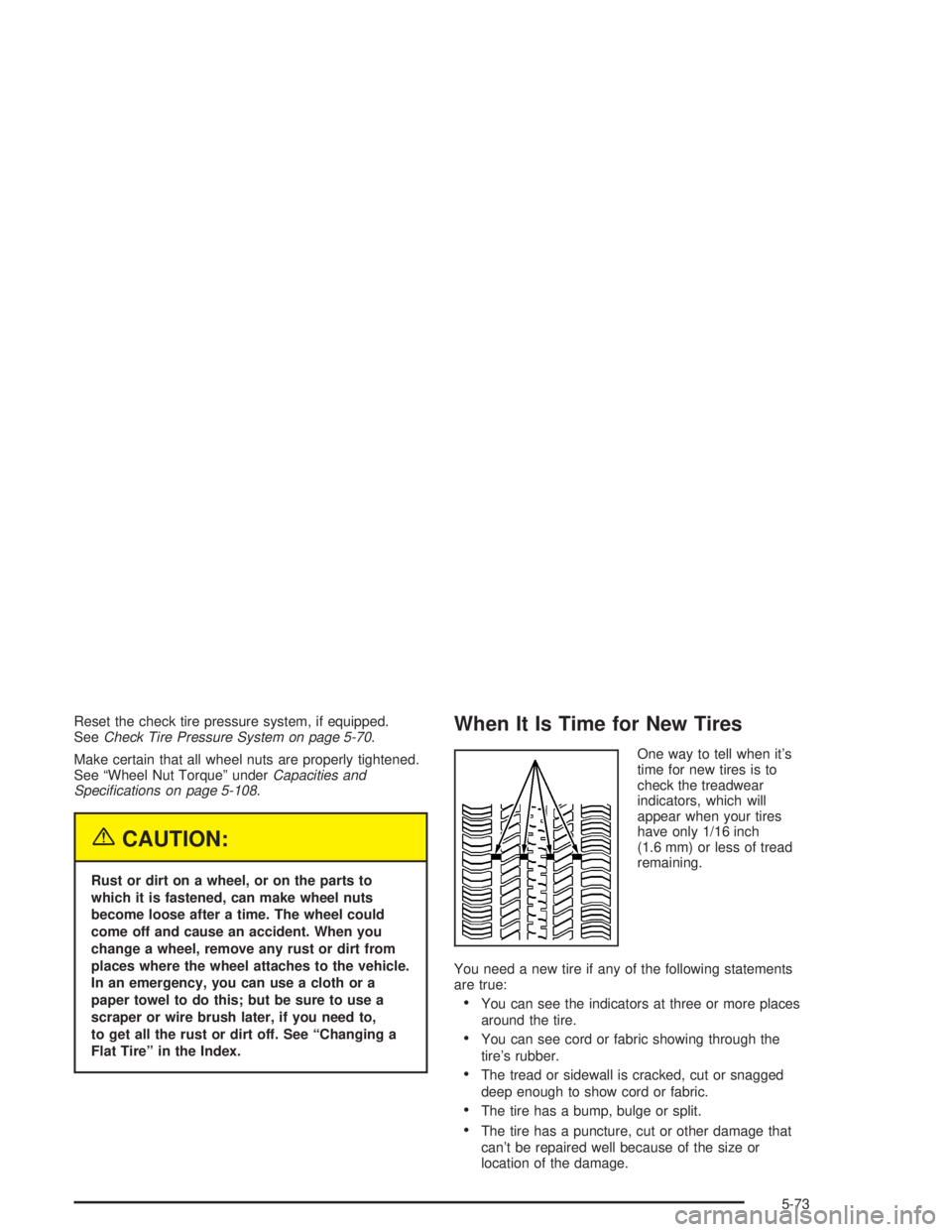
Reset the check tire pressure system, if equipped.
SeeCheck Tire Pressure System on page 5-70.
Make certain that all wheel nuts are properly tightened.
See “Wheel Nut Torque” underCapacities and
Speci�cations on page 5-108.
{CAUTION:
Rust or dirt on a wheel, or on the parts to
which it is fastened, can make wheel nuts
become loose after a time. The wheel could
come off and cause an accident. When you
change a wheel, remove any rust or dirt from
places where the wheel attaches to the vehicle.
In an emergency, you can use a cloth or a
paper towel to do this; but be sure to use a
scraper or wire brush later, if you need to,
to get all the rust or dirt off. See “Changing a
Flat Tire” in the Index.
When It Is Time for New Tires
One way to tell when it’s
time for new tires is to
check the treadwear
indicators, which will
appear when your tires
have only 1/16 inch
(1.6 mm) or less of tread
remaining.
You need a new tire if any of the following statements
are true:
You can see the indicators at three or more places
around the tire.
You can see cord or fabric showing through the
tire’s rubber.
The tread or sidewall is cracked, cut or snagged
deep enough to show cord or fabric.
The tire has a bump, bulge or split.
The tire has a puncture, cut or other damage that
can’t be repaired well because of the size or
location of the damage.
5-73
Page 330 of 410
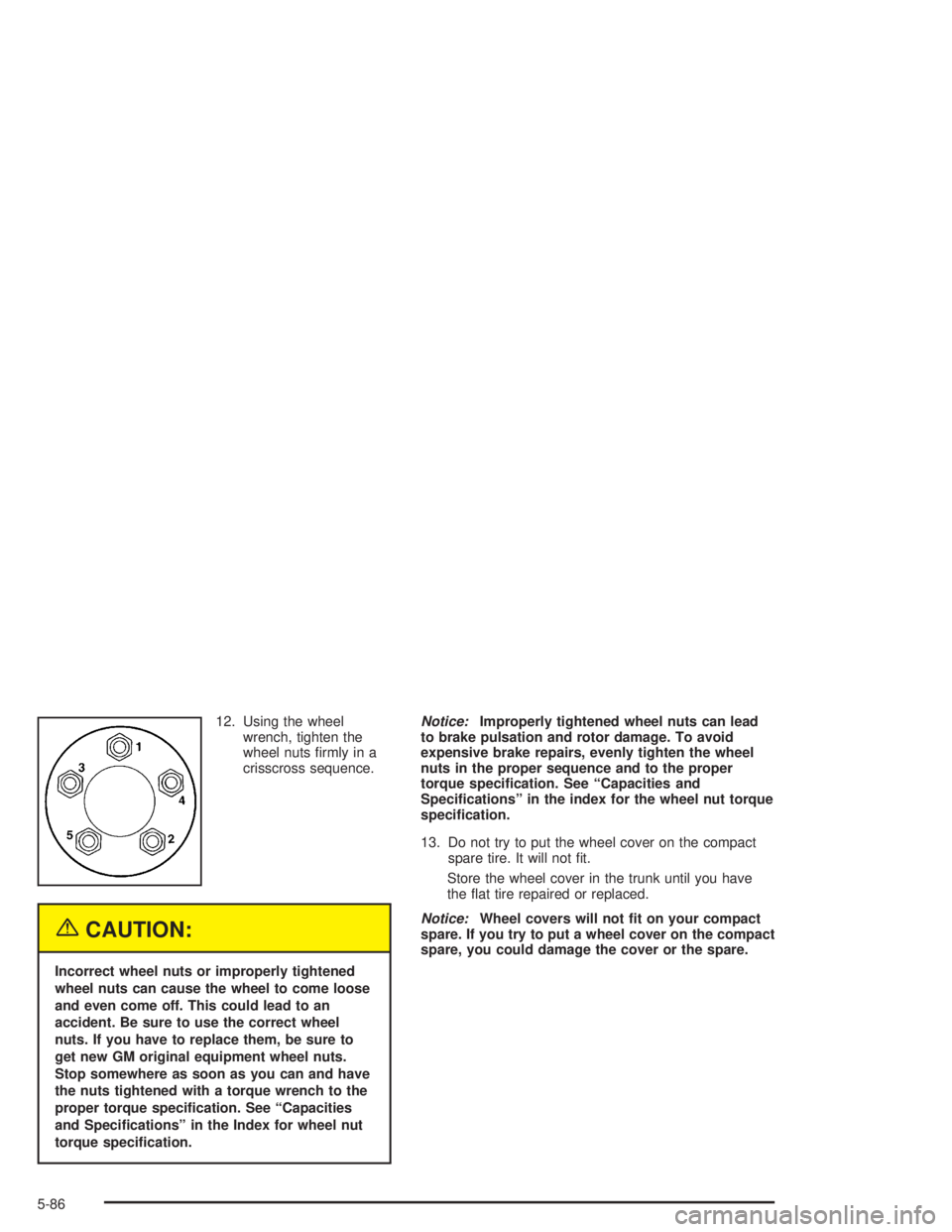
12. Using the wheel
wrench, tighten the
wheel nuts �rmly in a
crisscross sequence.
{CAUTION:
Incorrect wheel nuts or improperly tightened
wheel nuts can cause the wheel to come loose
and even come off. This could lead to an
accident. Be sure to use the correct wheel
nuts. If you have to replace them, be sure to
get new GM original equipment wheel nuts.
Stop somewhere as soon as you can and have
the nuts tightened with a torque wrench to the
proper torque speci�cation. See “Capacities
and Speci�cations” in the Index for wheel nut
torque speci�cation.Notice:Improperly tightened wheel nuts can lead
to brake pulsation and rotor damage. To avoid
expensive brake repairs, evenly tighten the wheel
nuts in the proper sequence and to the proper
torque speci�cation. See “Capacities and
Speci�cations” in the index for the wheel nut torque
speci�cation.
13. Do not try to put the wheel cover on the compact
spare tire. It will not �t.
Store the wheel cover in the trunk until you have
the �at tire repaired or replaced.
Notice:Wheel covers will not �t on your compact
spare. If you try to put a wheel cover on the compact
spare, you could damage the cover or the spare.
5-86
Page 352 of 410

Capacities and Speci�cations
The following approximate capacities are given in English and metric conversions. Please refer toPart D:
Recommended Fluids and Lubricants on page 6-25for more information.
Capacities
ApplicationCapacities
English Metric
Air Conditioning Refrigerant R134a 2.2 lbs 1.0 kg
Automatic Transaxle 7.4 quarts 7.0 L
Engine Cooling System 13.0 quarts 12.3 L
Engine Oil with Filter 4.5 quarts 4.3 L
Fuel Tank 18.5 gallons 70.0 L
Wheel Nut Torque 100 lb-ft 140Y
All capacities are approximate. When adding, be sure to �ll to the appropriate level, as recommended in this
manual.
Engine VIN Code Transmission Spark Plug Gap
3800 3.8L V6 (L36) K Automatic 0.060 inch (0.152 cm)
3800 3.8L V6 Supercharged
Engine (L67)1 Automatic 0.060 inch (0.152 cm)
5-108
Page 408 of 410
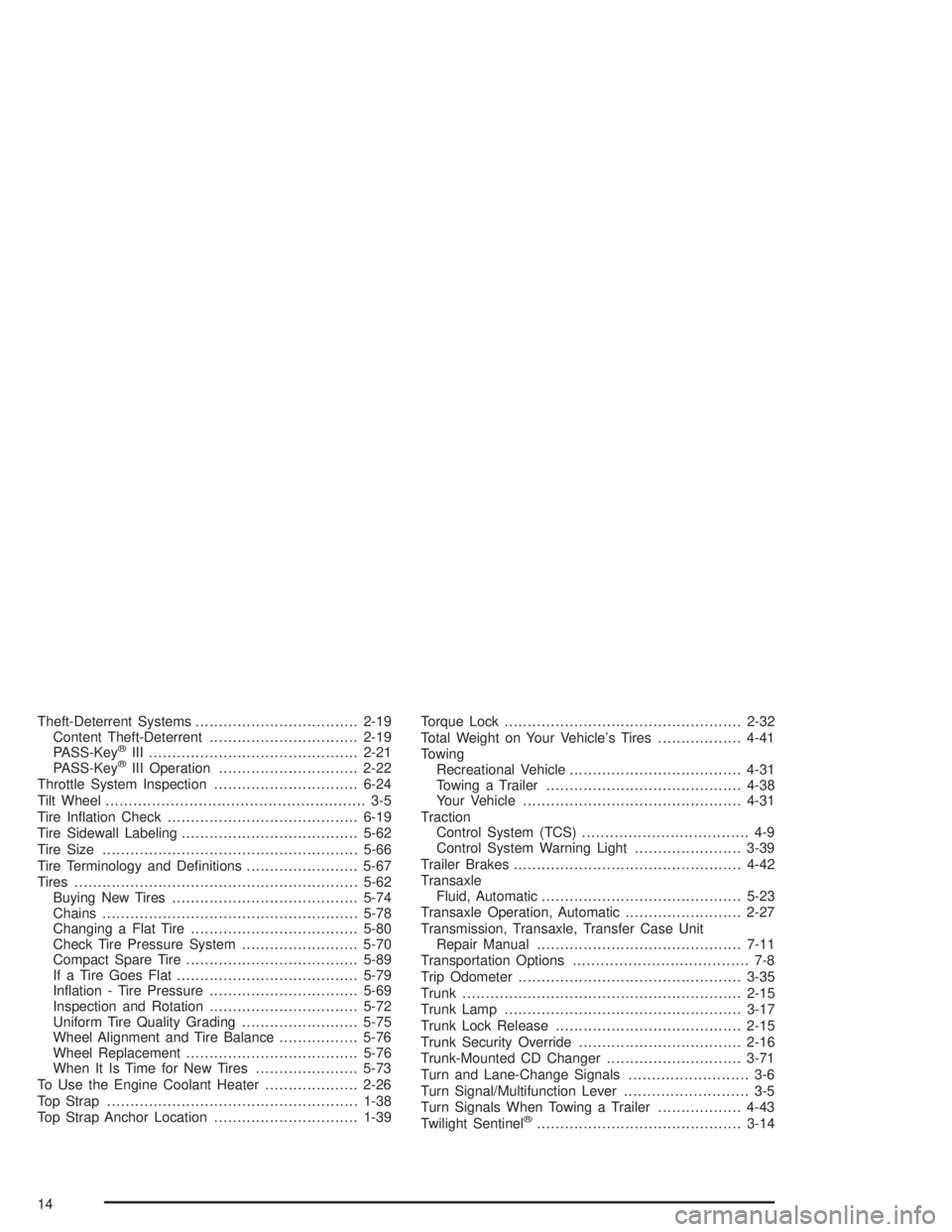
Theft-Deterrent Systems...................................2-19
Content Theft-Deterrent................................2-19
PASS-Key
®III .............................................2-21
PASS-Key®III Operation..............................2-22
Throttle System Inspection...............................6-24
Tilt Wheel........................................................ 3-5
Tire In�ation Check.........................................6-19
Tire Sidewall Labeling......................................5-62
Tire Size.......................................................5-66
Tire Terminology and De�nitions........................5-67
Tires.............................................................5-62
Buying New Tires........................................5-74
Chains.......................................................5-78
Changing a Flat Tire....................................5-80
Check Tire Pressure System.........................5-70
Compact Spare Tire.....................................5-89
If a Tire Goes Flat.......................................5-79
In�ation - Tire Pressure................................5-69
Inspection and Rotation................................5-72
Uniform Tire Quality Grading.........................5-75
Wheel Alignment and Tire Balance.................5-76
Wheel Replacement.....................................5-76
When It Is Time for New Tires......................5-73
To Use the Engine Coolant Heater....................2-26
Top Strap......................................................1-38
Top Strap Anchor Location...............................1-39Torque Lock...................................................2-32
Total Weight on Your Vehicle’s Tires..................4-41
Towing
Recreational Vehicle.....................................4-31
Towing a Trailer..........................................4-38
Your Vehicle...............................................4-31
Traction
Control System (TCS).................................... 4-9
Control System Warning Light.......................3-39
Trailer Brakes.................................................4-42
Transaxle
Fluid, Automatic...........................................5-23
Transaxle Operation, Automatic.........................2-27
Transmission, Transaxle, Transfer Case Unit
Repair Manual............................................7-11
Transportation Options...................................... 7-8
Trip Odometer................................................3-35
Trunk............................................................2-15
Trunk Lamp...................................................3-17
Trunk Lock Release........................................2-15
Trunk Security Override...................................2-16
Trunk-Mounted CD Changer.............................3-71
Turn and Lane-Change Signals.......................... 3-6
Turn Signal/Multifunction Lever........................... 3-5
Turn Signals When Towing a Trailer..................4-43
Twilight Sentinel
®............................................3-14
14